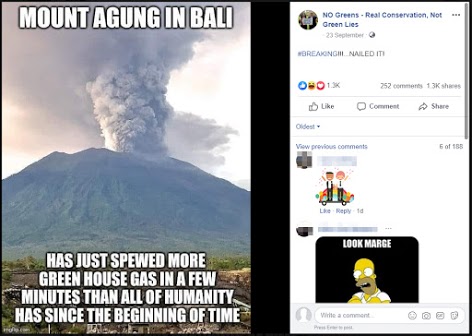The Statement
AAP FactCheck examined a Facebook post from September 23, 2019, by an Australian page, “NO Greens – Real Conservation, Not Green Lies” featuring a photo of Indonesia’s Mount Agung, an active volcano, erupting.

Text overlaid on the image reads: “Mount Agung in Bali has just spewed more greenhouse gas in a few minutes than all of humanity has since the beginning of time.”
Text in the post reads: “#BREAKING!!!…NAILED IT!”
The post has been shared more than 1,300 times and attracted more than 250 comments and 1,300 reactions.
The Analysis
Mount Agung, also known as Gunung Agung, meaning ‘Great Mountain’, is a volcano located in northeastern Bali, Indonesia.
In 1963 it erupted for the first time in 120 years, killing more than 1,000 people and leaving tens of thousands homeless.
The volcano has been active again since 2017.
The image featured in the post was taken on November 27, 2017, and is credited to Michael W. Ishak at My Reef’s Diary, a travel group.
The activity in 2017 resulted in about 150,000 people being evacuated from the area.
Volcanic eruptions can inject significant amounts of carbon dioxide (CO2), a major greenhouse gas, into the atmosphere, according to the US Geological Survey. The USGS said the 1980 eruption of Washington’s Mount St Helens released approximately 10 millions tons of CO2 into the atmosphere in just nine hours. But humans emit even more, the organisation said.
“It currently takes humanity only 2.5 hours to put out the same amount. While large explosive eruptions like this are rare and only occur globally every 10 years or so, humanity’s emissions are ceaseless and increasing every year,” the USGS says in an article on its website.
USGS scientist Terry Gerlach, in a 2011 paper published by the American Geophysical Union, said that volcanic emissions include CO2 from “erupting magma and from degassing of unerupted magma beneath volcanoes”.
Dr Gerlach wrote in that paper that: “The climate change debate has revived and reinforced the belief, widespread among climate skeptics, that volcanoes emit more CO2 than human activities. In fact, present-day volcanoes emit relatively modest amounts of CO2, about as much annually as states like Florida, Michigan, and Ohio”.
University of New South Wales physical meteorology and atmospheric climate dynamics expert Professor Steven Sherwood told AAP FactCheck that “on average over time, volcanoes emit about one percent as much CO2 as humanity.”
“Humanity emits enough CO2 to cover the entire Earth with a 2cm layer every year, way more than any volcano. Since the ‘beginning of time’ humanity has emitted billions of cubic kilometers of CO2,” he said in an email.
Professor Sherwood said the recent Mt Agung eruptions in 2017 and 2019 were “quite average”.
“Agung erupted much more violently in 1963, and we’ve had several others since that have reached well into the stratosphere,” he said,
A similar conclusion was reached by the British Geological Survey in a paper entitled ‘Volcanic Contributions to the Global Carbon Cycle’, published in 2005.
The British Geological Survey said, in the summary of the paper: “Present day geological emissions of CO2 include both volcanic emissions (both passive, from volcanoes in repose, and those related directly to eruptive activity) and non-volcanic – direct emissions from the Earth’s crust and lithosphere. The contribution to the present day atmospheric CO2 loading from volcanic emissions is, however, relatively insignificant, and it has been estimated that subaerial volcanism releases around 300 Mt/year CO2, equivalent to just 1% of anthropogenic emissions.”
University of Queensland greenhouse gas emissions researcher Dr Alistair Grinham also told AAP FactCheck humans “contribute far more greenhouse gas to the atmosphere than volcanoes.”
“A recent estimate for the annual contribution from volcanoes is approximately 0.65 gigatonnes…whereas humans are currently contributing over 50 gigatonnes,” Dr Grinham wrote in an email.
The Verdict
Based on the evidence, AAP FactCheck concluded that the claim in the post is false. Expert researchers in climate science, volcanology and greenhouse gases,the US Geological Survey and the British Geological Survey have found that humans contribute far more greenhouse gas to the environment than all the world’s volcanoes. UNSW’s Professor Steven Sherwood stated that “on average over time, volcanoes emit about one percent as much CO2 as humanity”.
False – The primary claim of the content is factually inaccurate.
First published September 27, 2019, 13:20 AEST


















